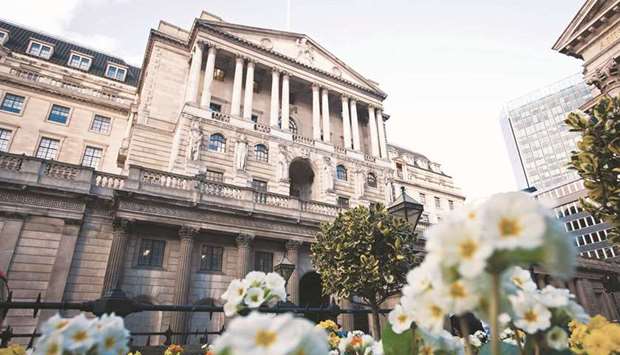The Bank of England said inflation would surpass 3% as Britain’s locked-down economy reopens, but the climb further above its 2% target would only be “temporary” and most policymakers favoured keeping stimulus at full throttle.
Sterling fell as the BoE’s nine monetary policymakers voted 8-1 again to keep their government bond-buying programme at £875bn ($1.22tn). Some investors had bet there would be greater dissent.
That would have been a signal that the BoE was speeding up its thinking about unwinding the huge stimulus that has helped steer the world’s fifth-biggest economy through the Covid-19 crisis.
But even as the BoE raised its short-term growth forecasts, only chief economist Andy Haldane, who leaves the BoE this month, voted to scale back the bond-buying plan by £50bn , his second consecutive vote of dissent.
With Britain about to start phasing out its state-funded jobs safety-net, Covid-19 cases on the rise again and Brexit tensions still bubbling with the European Union, the central bank emphasised it saw no need to cut its support now.
Most Monetary Policy Committee (MPC) members felt they should “lean strongly against downside risks to the outlook and ensure that the recovery was not undermined by a premature tightening in monetary conditions”, the BoE said.
Last week, the US Federal Reserve began to move towards reducing its pandemic stimulus by signalling its first rate hike in 2023, a year earlier than previous projections, putting the focus on what other central banks might do next.
The MPC voted 9-0 to keep the Bank Rate at its all-time low of 0.1% and the BoE’s £20bn corporate bond programme unchanged.
The pound weakened by 0.3% against the US dollar and British government bond yields fell.
Rate futures were fully pricing in a rise in the BoE’s main interest rate to 0.25% in August 2022.
On Wednesday, investors had been betting on a hike in 12 months’ time.
“We continue to see scope for the MPC to begin raising rates in H2 2022 as the economy shows signs of recovery,” Marc Cogliatti, principal for global markets at Validus Risk Management.”If inflation remains stubbornly above target and doesn’t fall back as expected, there will be justification for the committee to act sooner.”
British consumer price inflation jumped to 2.1% in May, a long way below the US rate of 5% but surpassing the BoE’s 2% target level sooner than the central bank had forecast.
Last month, the BoE had projected CPI would hit 2.5% in late 2021 before easing back to 2%. Its new forecast was in line with recent forecasts by several private-sector economists.
“CPI inflation was expected to pick up further above the target, owing primarily to developments in energy and other commodity prices, and was likely to exceed 3% for a temporary period, peaking higher than previously thought,” the BoE said.
The MPC would look at “medium-term inflation expectations, rather than factors that are likely to be transient”. The BoE revised up its estimate for the level of GDP in the April-June period by 1.5 percentage points and output in June was forecast to be around 2.5% below its pre-pandemic level at the end of 2019.
But the central bank said policymakers were split on whether this faster-than-expected catch-up meant growth would be any faster over the medium term.
While the BoE is watching inflation, it is also concerned about a possible rise in unemployment.
The government will ask employers to start contributing to the cost of keeping on furloughed workers from July 1 before scrapping the scheme at the end of September.
Data published earlier yesterday showed the proportion of employees on furlough in early June fell to its lowest since the start of the pandemic at 6% of staff.
The BoE must also factor in risks from a new rise in Covid-19 cases, which on Wednesday hit their highest since February, and the government has delayed the lifting of the last social-distancing rules.

A view of the Bank of England in London. The BoE’s nine monetary policymakers voted 8-1 again yesterday to keep their government bond-buying programme at u00a3875bn ($1.22tn).
